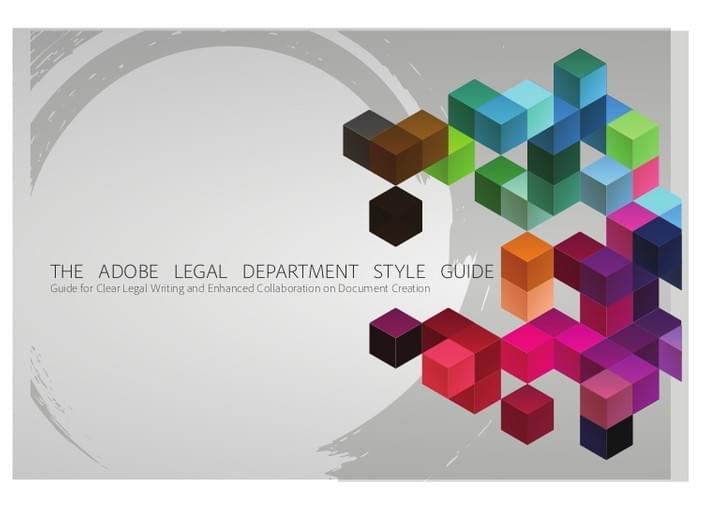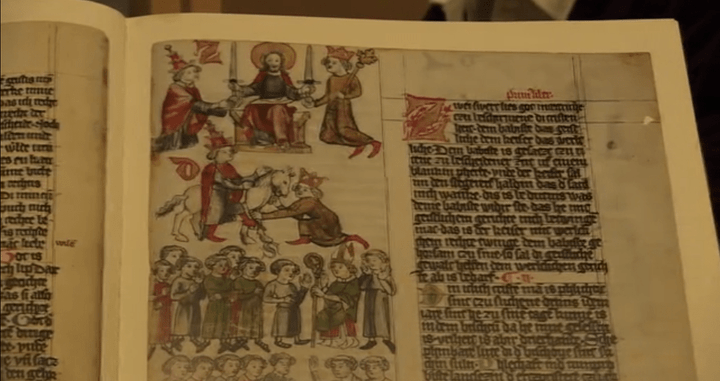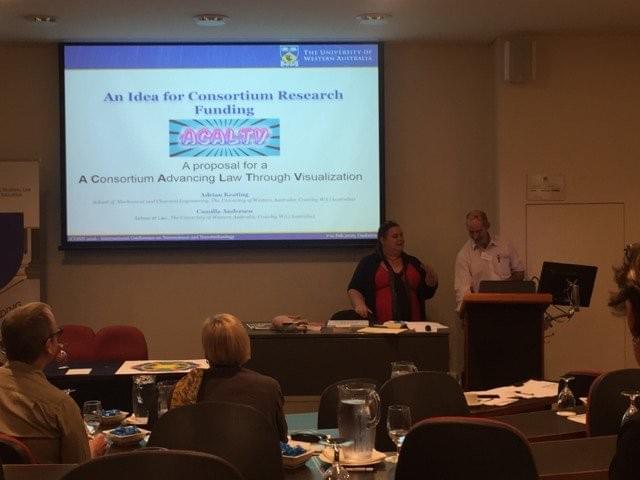



COMIC BOOK CONTRACTS
- Our Vision
- People And Research
- …
- Our Vision
- People And Research



COMIC BOOK CONTRACTS
- Our Vision
- People And Research
- …
- Our Vision
- People And Research

Day 1 - Session One - Where Are We Now?

Day One of the conference started off with a panel discussion with John McGuire, Lawyer Robert De Rooy and Professor Camilla Baasch Andersen entitled 'Where Are We Now?' The session discusses the current complexities surrounding contract law. As explained by Robert De Rooy, contracts are necessarily complex in some cases but for many other cases, such as for employees and even families, they are unnecessarily complex. As such, visual contracting would help everyday individuals better understand what is expected of them.
The picture on the right forms part of an employment contract designed by Robert De Rooy highlighting how visualisation helps employees better understand their obligations. The photo shows how much fruit is expected from a fruit picker as part of their employment. Robert De Rooy's employment contract also visualises employees other duties and entitlements. One issue Robert mentioned was that employees were unaware that they had particular duties or that they were unaware they had to inform their employer when they were taking leave. This was due to both cultural and language barriers which prevented the employees from fully grasping their obligations. Visualised contracts seek to cut through these barriers and show what every individual understands: actions and emotion.

John McGuire, Chief Innovation Officer at Aurecon introduced the new visual contracts being used for new employees at Aurecon. In addition to showing the amazing, user friendly interface and intuitive visual contract, John McGuire described the complexities involved in designing a visual contract. He described the vast amount of thought and consideration that went into the selection of every image. For example, the photo on the right shows the welcome screen for a new Aurecon employee. The thought that went into the image of a lightbulb was simply enormous. McGuire stated how that the image of the lightbulb was deliberately chosen to highlight the great value that Aurecon placed into their employees. They are viewed as bright individuals with plenty of ideas and own identity. Other interesting topics that arose during McGuire's talk was the limitations involved with creating their visual contract. Aurecon had an amazing idea let individuals in fact choose their own avatar and how they want to represent themself. However, this was thwarted by the immense amount of combinations (in the 10,000's!) and programming time this would require.
Day 1 - Session Two - Successful Contracts
The following session was entitled 'Successful Contacts' led by Helena Haapio and Thomas Barton discussing the elements of successful contracting.
Here, Thomas Barton discusses how services such as Fizzy, a flight insurance product, is aimed to simplify the difficulties involved with flight insurance claims. It offers an absolute promise and is designed to be transparent with no legal complexities.
Contract innovators can learn from this and design contracts in much the same form - a product or service that appeals to its users by how it relieves the difficulties normally associated with contract law.

Helena Haapio follows by discussing how her team at Lexpert are incorporating the elements of successful contracting both in substance but also form.
The layout and general presentation of a contract is just as important as the substance of a contract. When designing contracts it is important to consider visual aspects such as font size, spacing and placement as well as the use of certain graphical elements such as tables. No one wants to read a giant slab of text line after line but they are more likely to read text of varying font types, sizes which are organised in a visually appealing manner. While not discussing the use of images in contracts, Helena's talk highlighted how text itself can be be presented in a more visually appealing manner that draws users.
One company that aims to reduce obscurity and in contract and legal documents is Adobe. Adobe's legal department have made their style guide public in order to increase transparency and communication in their legal documents. Their legal style guide, which can be viewed here shows the template that the Adobe legal team themselves use when drafting documents. It is a very valuable tool that shows how the legal team format their documents and the reasoning behind it.
Day 1 - Session Three - Innovation in Thinking and Behaviour

After lunch, J. Kim Wright talked on the importance of 'paradigm shifts' in her session 'Innovation in Thinking and Behaviour'. J. Kim Wright discusses how it is the responsibility of current and future legal professionals to advocate for changes in the legal profession. Wright's talk highlights how the traditional, old-fashioned approach and values in law have meant that lawyers and legal professionals are used to practicing and approaching the law through one perspective. This means that legal professionals are not able to employ creative problem solving strategies that would ease the burdens associated with the law for lay people who have little knowledge of it. As such, a shift in perspective is needed.
What do you see on the left here? A frog? Try turn your head and maybe you can see more than one answer!
Day 1 - Session Four - Breaking the Lawyer's Silo and Live Q&A with Robert Sikoryak

Is it a bird? Is it a plane? No! It's Robert Sikoryak joining us live at the conference! Big thank you to Robert who stayed up till 3 am to join us at the conference to talk about his book "iTunes Terms and Conditions: The Graphic Novel." For those who may not know, "iTunes Terms and Conditions: The Graphic Novel" is a comic book styled representation of Apple iTune's infamously wordy terms and conditions. Robert has reproduced, word for word, every line of text in the terms and conditions and provided a comic-styled visual representation of Steve Jobs to accompany it!
While appearing via live feed Robert talked about the inspiration behind producing the book. He mentions how it was not only to provide a challenge to himself but to also poke fun at the absurdly long wall of text that nearly every person is expected to read through when logging onto iTunes. Robert also discusses his future projects and how, if the inspiration hits him again, he may just tackle another big block of text!
The conference followed with a discussion by Professors Camilla Andersen and Doctor Colette Brunschwig (appearing via pre-recorded video). Doctor Brunschwig talked in her live video of the Legal Visualisation Unit, part of the Legal Research Department in the University of Zurich. The Legal Visualisation Unit retains legal images and researches visualisation, audio-visualisation and 'multi-sensorization' in law. Doctor Brunschwig discussed how she was inspired to create the unit after discovering ancient Anglo-Saxon legal documents that had both text and images.
Following on, Doctor Brunschwig talked about how she sees the 'legal tech' movement seeing innovation such as comic book contracts being propelled into the future. However, in an interesting discussion Doctor Brunschwig along with Professor Andersen discussed why innovation has not happened sooner. Both discuss how educational legal institutions such as Law schools teach students that a 'verbo-centric' approach to studying and practicing law is the one and only way. Of course with such a mindset instilled in students who are still learning the foundations of law, this becomes the only mode of thinking for them. Both Professor Andersen and Doctor Brunschwig talk about how it is now the responsibility of law schools to teach innovation in law. Already, law schools here in Australia such as the University of Western Australia and Monash University have implemented innovation in law into their cirriculum. For example, the introduction of the Legal APPtitude unit teaching legal application design in UWA and contract law lectures discussing innovation in contract design.
See Doctor Brunschwig's interview below.

The day finished with the exciting launch of ACALTV (A Consortium Advancing Law Through Visualisation) by Professors Camilla Andersen and Adrian Keating. ACALTV aims to be a consortium for all participants to provide funding and promote research into not only comic book contracts but other forms of creative contracting. The launch by Professors Andersen and Keating discussed the membership structure and how members in the consortium can directly benefit from all research.
Stay tuned here for more information regarding ACALTV!






